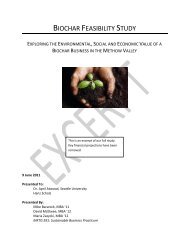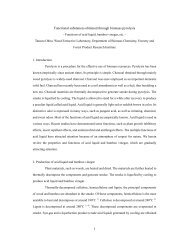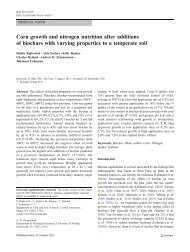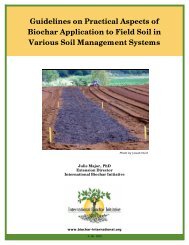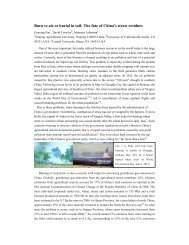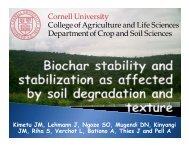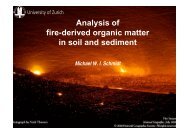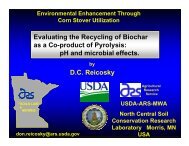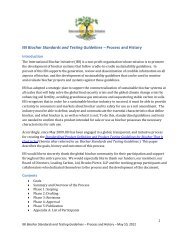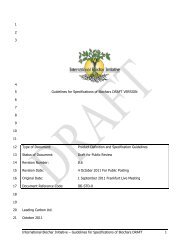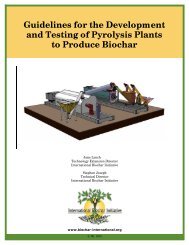Guidelines for Specifications of Biochars for Use in Soils FINAL ...
Guidelines for Specifications of Biochars for Use in Soils FINAL ...
Guidelines for Specifications of Biochars for Use in Soils FINAL ...
You also want an ePaper? Increase the reach of your titles
YUMPU automatically turns print PDFs into web optimized ePapers that Google loves.
123456789101112131415161718192021222324252627282930313233343536biomass. These materials <strong>in</strong>clude soils and common constituents <strong>of</strong> natural soils, such as claysand gravel that may be gathered with biomass or <strong>in</strong>termixed through prior use <strong>of</strong> the feedstockbiomass. Diluents/dilutants may be found <strong>in</strong> a diverse range <strong>of</strong> feedstocks, such as agriculturalresidues, manures, and municipal solid wastes (IBI).Feedstock: The material undergo<strong>in</strong>g the thermochemical process to create biochar. Feedstockmaterial <strong>for</strong> biochar consists <strong>of</strong> biological material, but may also conta<strong>in</strong> diluents (IBI).Fossil-Fuel-Derived Chemical Compounds: This category <strong>of</strong> contam<strong>in</strong>ant <strong>in</strong>cludes any compound<strong>of</strong> a synthetic nature, created from hydrocarbons, <strong>in</strong>clud<strong>in</strong>g, but not limited to plastics, solvents,pa<strong>in</strong>ts, res<strong>in</strong>s, and tars. Because <strong>of</strong> the blend<strong>in</strong>g <strong>of</strong> wastes and use <strong>of</strong> synthetic materials tob<strong>in</strong>d and label other materials (e.g. plastic flagg<strong>in</strong>g tape <strong>in</strong> <strong>for</strong>estry residues), fossil-fuel-derivedchemical compounds have become commonplace <strong>in</strong> multiple waste streams, and are <strong>of</strong>tendifficult to separate from feedstocks prior to process<strong>in</strong>g. These contam<strong>in</strong>ants can conta<strong>in</strong> highlytoxic chemicals like polychlor<strong>in</strong>ated biphenyls (PCBs) that may act as bioaccumulators and affectthe result<strong>in</strong>g quality <strong>of</strong> biochar (IBI).Hazardous Materials or Wastes: Potential environmental pollutants that, when concentrated,can be a source <strong>of</strong> regulatory concern <strong>for</strong> any use or application that may <strong>in</strong>fluence human orenvironmental health and wellbe<strong>in</strong>g (adapted from US Compost<strong>in</strong>g Council and US Department<strong>of</strong> Agriculture 2001).Municipal Waste/ Municipal Solid Waste (MSW): solid non-hazardous refuse that orig<strong>in</strong>ates fromresidential, <strong>in</strong>dustrial, commercial, <strong>in</strong>stitutional, demolition, land clear<strong>in</strong>g, or constructionsources (Canadian Council <strong>of</strong> M<strong>in</strong>isters <strong>of</strong> the Environment 2005). Municipal solid waste <strong>in</strong>cludesdurable goods, non-durable goods, conta<strong>in</strong>ers and packag<strong>in</strong>g, food wastes and yard trimm<strong>in</strong>gs,and miscellaneous <strong>in</strong>organic wastes (US Environmental Protection Agency 2011).Organic Carbon: Biologically degradable carbon-conta<strong>in</strong><strong>in</strong>g compounds found <strong>in</strong> the organicfraction <strong>of</strong> biochar feedstocks. Biochar feedstocks can conta<strong>in</strong> such compounds as sugars,starches, prote<strong>in</strong>s, fats, cellulose, and lignocellulose, which are thermochemically degradable.Other organic carbon <strong>for</strong>ms can <strong>in</strong>clude petroleum and petroleum by-products such as plasticsand contam<strong>in</strong>ated oils, which are, <strong>for</strong> the purposes <strong>of</strong> this document, <strong>in</strong>cluded with<strong>in</strong> thedef<strong>in</strong>ition <strong>of</strong> contam<strong>in</strong>ants, but may also be thermochemically degraded. The organic carbonfraction does not <strong>in</strong>clude <strong>in</strong>organic carbonate concretions such as calcium and magnesiumcarbonates (adapted from US Compost<strong>in</strong>g Council and US Department <strong>of</strong> Agriculture 2001).Processed Feedstock: Biomass that has gone through chemical process<strong>in</strong>g (<strong>for</strong> example, paperpulp sludge) or biological process<strong>in</strong>g (<strong>for</strong> example, digestion, such as manures and sludge fromwaste effluent treatment) beyond simple mechanical process<strong>in</strong>g to modify physical properties.Because animals may bioaccumulate tox<strong>in</strong>s <strong>in</strong> their tissues, all animal parts and products areconsidered to be Processed Feedstocks <strong>for</strong> purposes <strong>of</strong> these guidel<strong>in</strong>es (IBI).International Biochar Initiative – <strong>Guidel<strong>in</strong>es</strong> <strong>for</strong> <strong>Specifications</strong> <strong>of</strong> <strong>Biochars</strong> <strong>for</strong> <strong>Use</strong> <strong>in</strong> <strong>Soils</strong> 36



